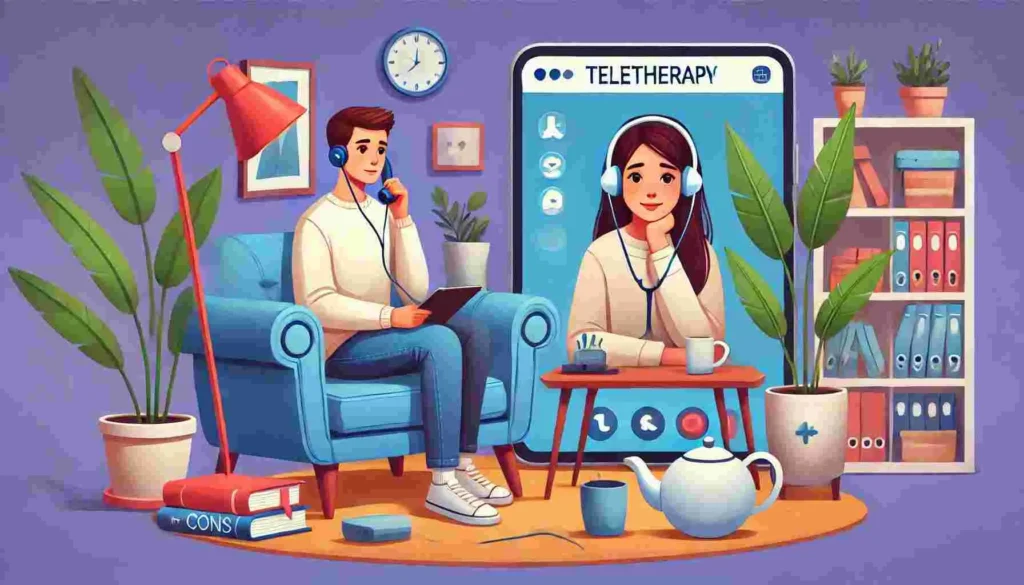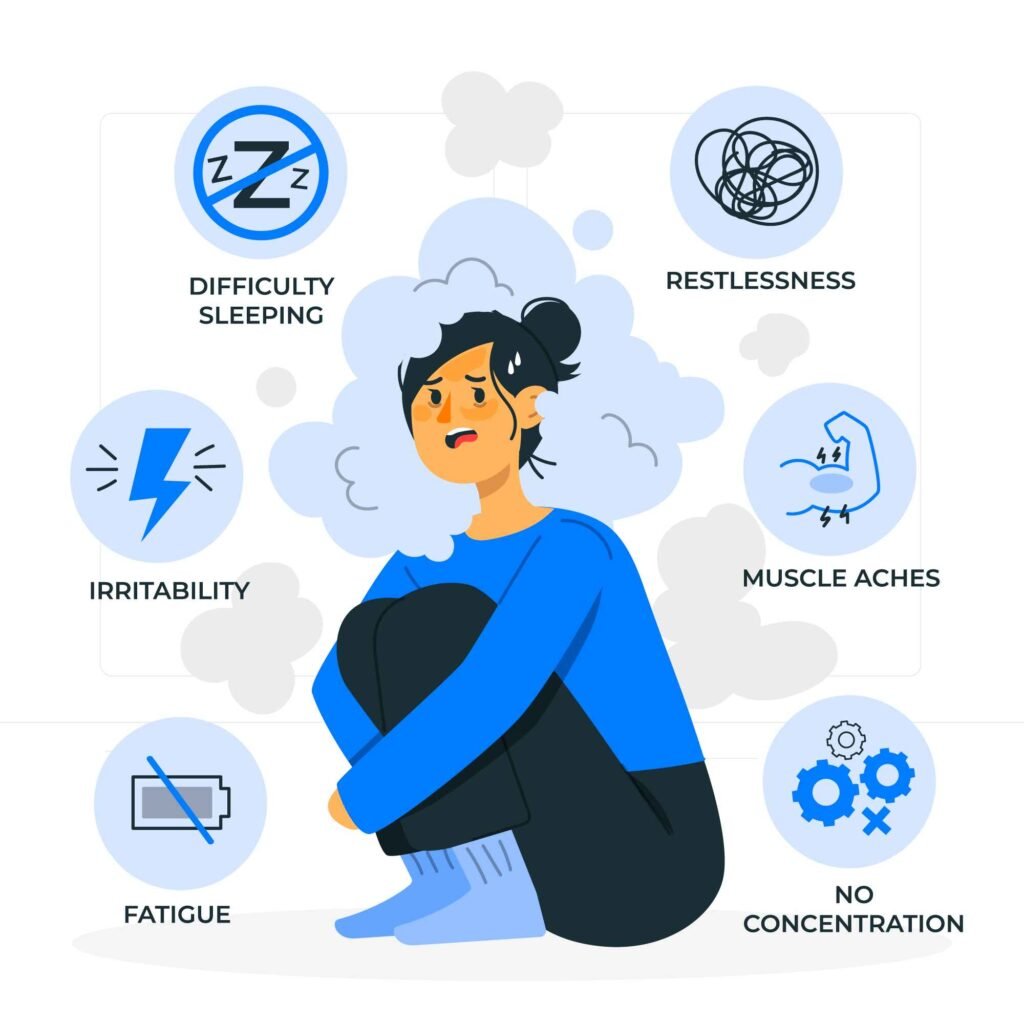
Teletherapy vs. In-Person Sessions: Pros and Cons
Teletherapy vs. In-Person Sessions: Pros and Cons
In recent years, mental health care has evolved significantly, with both teletherapy and in-person therapy emerging as popular options for individuals seeking professional help. The growing demand for flexible and accessible mental health services has made teletherapy a viable option for many people. However, despite its increasing popularity, in-person therapy remains a staple in the mental health field. In this blog post, we will explore the pros and cons of both teletherapy and in-person therapy, helping you understand which option may be best for your personal needs.
What is Teletherapy?
Teletherapy, also known as online therapy or virtual therapy, involves engaging in therapy sessions via the internet using video conferencing tools, phone calls, or messaging platforms. It allows individuals to receive therapy from the comfort of their own home or any location that is convenient for them. Teletherapy has gained traction due to its accessibility, especially in times when social distancing and quarantine measures make in-person visits challenging.
What is In-Person Therapy?
In-person therapy, often referred to as traditional face-to-face therapy, involves meeting with a licensed therapist in a physical location, such as a therapist’s office or clinic. This method allows individuals to have real-time, direct interactions with their therapists, providing a personal connection that is often seen as crucial in the therapeutic process. In-person therapy is the more conventional form of therapy and remains widely popular.
Pros of Teletherapy
1. Convenience and Flexibility
One of the most significant advantages of teletherapy is the convenience it offers. You can attend therapy sessions from anywhere with an internet connection, whether it’s from the comfort of your home, during a lunch break, or while traveling. This flexibility makes teletherapy particularly appealing to individuals with busy schedules or those who live in remote areas.
2. Accessibility
Teletherapy opens doors to mental health care for individuals who may otherwise struggle to access in-person therapy. People living in rural or underserved areas, those with mobility challenges, or individuals who face transportation difficulties can benefit greatly from teletherapy. It removes geographic barriers and allows individuals to connect with therapists who might not be available locally.
3. Comfort and Privacy
For many, the comfort of being at home during therapy sessions can make the experience feel safer and more private. People may feel less anxious about opening up in their own environment, especially if they find in-person therapy intimidating. The ability to attend therapy without leaving your home may also alleviate concerns about stigma, making it easier to seek help.
4. Reduced Risk of Exposure
Especially during the COVID-19 pandemic, teletherapy provided a safe alternative for those concerned about exposure to viruses in public spaces. Teletherapy allows individuals to continue receiving mental health care without the risk of coming into contact with germs in public spaces or offices, which is crucial for individuals with compromised immune systems.
5. Comfort for Remote or Shy Clients
Some individuals find it easier to open up to a therapist when they don’t have to be physically present in the same room. For those who may feel shy, introverted, or socially anxious, the distance offered by teletherapy can make therapy feel less intimidating. This sense of anonymity can encourage more honest and open discussions.
Cons of Teletherapy
1. Technology Issues
While teletherapy offers significant benefits, it’s not without its challenges. One common issue is technology-related problems, such as poor internet connectivity, software glitches, or incompatible devices. These technical issues can disrupt sessions, leading to frustrations and communication breakdowns. Not everyone is tech-savvy, which can add an extra layer of stress for clients who struggle with technology.
2. Limited Non-Verbal Communication
In-person therapy allows both the therapist and client to observe body language, facial expressions, and other non-verbal cues that are important in understanding emotions and reactions. In teletherapy, these cues can sometimes be missed or misinterpreted due to video quality or technical limitations. This can hinder the therapist’s ability to fully gauge the client’s emotional state and respond appropriately.
3. Lack of Personal Connection
Some individuals may feel that teletherapy lacks the personal connection that comes with face-to-face interactions. For many, the in-person experience creates a bond and a sense of trust that is difficult to replicate in a virtual setting. The physical presence of a therapist can create a sense of security and emotional support that some clients may miss during teletherapy.
4. Privacy Concerns
While teletherapy can offer greater privacy in terms of being at home, it also introduces potential security and confidentiality issues. Video calls and online platforms are susceptible to hacking or data breaches, which could compromise the confidentiality of the session. Additionally, some clients may not have private spaces at home to discuss sensitive topics, which can make them feel exposed or uncomfortable.
Pros of In-Person Therapy
1. Personal Connection and Trust
In-person therapy allows for a deeper personal connection between the therapist and the client. Face-to-face interactions enable therapists to read body language, observe subtle emotional cues, and establish a stronger bond with their clients. This connection can lead to increased trust, which is essential for successful therapy. Many individuals feel more supported when they are physically present with their therapist.
2. Clearer Communication
In-person sessions provide a clearer and more direct form of communication. Both verbal and non-verbal cues can be fully understood, which helps the therapist to assess the emotional state of the client more accurately. This is particularly important for individuals who have difficulty articulating their thoughts or emotions.
3. No Technology Barriers
Unlike teletherapy, in-person therapy does not rely on technology, so there are no concerns about internet connectivity or software glitches. Clients can focus entirely on the therapy session without worrying about technical difficulties. For those who are not comfortable using online platforms or who lack access to reliable technology, in-person therapy is a more reliable option.
4. Structured Environment
The setting of in-person therapy can create a structured and dedicated space for healing. The therapist’s office or clinic is a neutral space where the client can feel safe and focused solely on the therapy process. This environment is conducive to privacy and allows clients to escape distractions that may exist at home.
5. Therapist’s Full Attention
In an in-person session, the therapist is fully present with the client without any distractions from outside factors. The therapist can focus on the individual, their concerns, and their emotional responses in real-time. This can lead to more effective and meaningful therapeutic interactions.
Teletherapy vs. In-Person Sessions: Pros and Cons (Second Half)
In the first half of this article, we explored the benefits and challenges of both teletherapy and in-person therapy. We highlighted the convenience, accessibility, and comfort of teletherapy, as well as the personal connection, clear communication, and structured environment of in-person therapy. In this second half, we will look at the remaining drawbacks of in-person therapy, and then provide a comparison between the two to help you decide which option is best suited for your mental health journey.
Cons of In-Person Therapy
1. Travel Time and Inconvenience
One of the main drawbacks of in-person therapy is the time and effort required to travel to a therapist’s office. For individuals with busy schedules or those living in rural or suburban areas, commuting to therapy can become an obstacle. The time spent in traffic or on public transportation can add unnecessary stress to the process, potentially leading to late arrivals or missed appointments. Moreover, the time commitment of in-person therapy can make it difficult to fit regular sessions into a busy lifestyle.
2. Limited Flexibility
Unlike teletherapy, which can be conducted from virtually anywhere, in-person therapy requires clients to be physically present at the therapist’s office. This lack of flexibility can be a challenge for individuals who have unpredictable schedules, young children to care for, or significant work commitments. While therapists may offer extended hours, it is often harder to find a convenient time slot, which can lead to delays in seeking treatment or gaps in therapy sessions.
3. Stigma and Privacy Concerns
Although the stigma surrounding therapy has significantly decreased in recent years, some individuals may still feel uncomfortable or self-conscious about attending in-person therapy. The thought of being seen entering or leaving a therapist’s office can cause anxiety for people worried about judgment from others. This concern is particularly relevant for those living in small towns or close-knit communities where privacy may be harder to maintain. As a result, some people may hesitate to seek the mental health care they need because they feel exposed or vulnerable.
4. Scheduling Challenges
For many people, finding an in-person therapist who fits their schedule and needs can be challenging. In busy cities, therapists may have full schedules, making it difficult to book regular sessions. Additionally, clients may have to deal with cancellations or rescheduling, which can disrupt the consistency of therapy. On the other hand, teletherapy offers more flexible scheduling options, often with a wider range of availability, making it easier for clients to find a suitable time.
5. Limited Options in Rural Areas
For individuals who live in rural or underserved areas, access to quality mental health care can be limited. In-person therapy options may be scarce, and the therapist options available may not specialize in the specific areas or conditions that a client needs help with. Teletherapy, in contrast, removes these geographic barriers, providing access to a wider range of therapists from around the world, regardless of where the client is located.
Teletherapy vs. In-Person Therapy: A Direct Comparison
Now that we have explored the individual pros and cons of teletherapy and in-person therapy, let’s compare the two in a few key areas to help you decide which is the best option for you.
1. Accessibility and Convenience
When it comes to accessibility and convenience, teletherapy is a clear winner. With teletherapy, you can access therapy sessions from anywhere, whether it’s your home, office, or even while on vacation. This means you don’t have to worry about travel time, scheduling conflicts, or finding childcare. Teletherapy also makes it easier to fit therapy into your busy life, offering more flexible appointment times. In contrast, in-person therapy often requires travel, which can be time-consuming and inconvenient for individuals with busy or unpredictable schedules.
2. Personal Connection and Communication
In-person therapy offers a personal connection that can be difficult to replicate virtually. Face-to-face interactions allow for clear communication through both verbal and non-verbal cues. Many people feel that the personal presence of the therapist helps to build a stronger bond, which can enhance trust and the overall therapeutic process. However, teletherapy has come a long way in recent years, and with the help of high-quality video conferencing tools, many people still feel a strong sense of connection during virtual sessions. If you value the personal connection and emotional cues, in-person therapy might be the better choice. But if you’re comfortable with the digital format, teletherapy can still provide meaningful, effective sessions.
3. Privacy and Confidentiality
Both teletherapy and in-person therapy prioritize confidentiality, but the risks associated with privacy can differ. In-person therapy takes place in a controlled environment, such as a therapist’s office, which ensures that the conversation remains private. On the other hand, teletherapy can present additional risks due to the use of online platforms and potential technical vulnerabilities. However, reputable teletherapy platforms use encryption and secure connections to protect your information. For those who have concerns about privacy in their home environment (e.g., being overheard by family members), in-person therapy provides a more secure option.
4. Emotional Comfort and Safety
For some people, being in the same physical space as their therapist provides a sense of emotional safety and comfort. The therapist’s office is often viewed as a neutral space that fosters open communication. For others, teletherapy offers a greater sense of comfort by allowing clients to stay in their familiar home environment, where they may feel more at ease. It all depends on your personal preference and what makes you feel the most comfortable during therapy.
5. Cost and Insurance Coverage
In terms of cost, teletherapy may have an advantage. Many teletherapy platforms offer affordable pricing structures and can be more cost-effective due to the lack of overhead costs (such as office space). Additionally, teletherapy can reduce travel expenses and time off work, which makes it a more budget-friendly option for some. However, some people may find that their insurance plan covers in-person therapy sessions but not teletherapy. It’s important to check with your insurance provider to see what services are covered under your plan.
6. Specialized Therapy Options
Teletherapy provides a wider range of options when it comes to selecting a therapist who matches your specific needs. Whether you’re looking for someone who specializes in cognitive behavioral therapy (CBT), couples therapy, or trauma-informed care, teletherapy allows you to choose from a larger pool of therapists. In-person therapy, however, may limit you to professionals in your local area, which can be restrictive, particularly if you’re searching for a therapist with specific expertise.
Which Option is Right for You?
Choosing between teletherapy and in-person therapy ultimately comes down to your personal preferences, lifestyle, and specific mental health needs. If you value convenience, flexibility, and accessibility, teletherapy may be the better option. It’s especially useful for individuals who live in remote areas, have mobility challenges, or need a more flexible schedule.
On the other hand, if you prioritize building a strong personal connection with your therapist, need clear face-to-face communication, or find comfort in a structured, controlled environment, in-person therapy may be the better fit for you. In-person therapy can also provide a sense of emotional safety and privacy that some individuals may find essential for their healing process.
The most important thing is to choose the option that makes you feel most comfortable and supported in your mental health journey. Whether you choose teletherapy or in-person therapy, what matters most is finding a therapeutic approach that works for you and supports your growth and well-being.
Practical Considerations for Both Options
When it comes to deciding between teletherapy and in-person therapy, the practical considerations play a significant role in determining what works best for you. Let’s break down the factors that might affect your decision based on specific circumstances and lifestyle preferences.
1. Technological Requirements for Teletherapy
Teletherapy requires reliable technology to ensure smooth communication during sessions. For individuals who are unfamiliar with video conferencing platforms or who have limited access to high-speed internet, teletherapy may pose some challenges. Having a stable internet connection, a quiet space, and a device with a camera are essential for ensuring that virtual sessions go smoothly. If you encounter technological difficulties, it can disrupt the session, leaving you feeling frustrated.
On the other hand, in-person therapy doesn’t rely on technology or external factors like internet speed, which ensures a more consistent experience. If you’re someone who prefers to avoid technology-related issues, you may find in-person sessions to be a more straightforward and less stressful option.
2. Tailored Therapy to Your Needs
Therapists often have different methods of working with clients, and some may be more comfortable or effective using in-person sessions, while others thrive in the teletherapy environment. If you’re dealing with certain conditions like trauma, anxiety, or depression, you might find it beneficial to meet your therapist face-to-face to better process emotions or reactions. In-person therapy can allow you to work with the therapist on non-verbal cues and offer a greater sense of presence during sessions.
However, there are many types of therapy that can be just as effective remotely, such as cognitive behavioral therapy (CBT), mindfulness-based therapy, and talk therapy. Teletherapy can work well for clients who are able to engage in the therapeutic process through conversation and self-reflection. If you feel that the setting of the therapy session – whether virtual or physical – has an impact on your success in therapy, that’s something to consider.
3. The Role of Medication Management and Support
For clients who are undergoing therapy as part of a broader treatment plan that includes medication, teletherapy can also be a convenient option. Many therapists work closely with psychiatrists and other mental health professionals to manage medications for conditions such as depression, anxiety, or bipolar disorder. While medication management often involves face-to-face consultations, teletherapy has evolved to include ways for therapists to manage prescriptions, monitor progress, and address concerns virtually.
In-person sessions may be preferable if medication management and therapy require a more hands-on approach. This is especially important for individuals who are receiving complex treatment or need closer monitoring of their mental health conditions. The ability to observe physical signs of emotional distress or medication side effects can be important for therapists and psychiatrists when adjusting treatment.
4. Group Therapy and Support Groups
Both teletherapy and in-person therapy offer group therapy sessions, but there are some notable differences between the two. In-person group therapy allows individuals to interact with others in a shared space, helping to build community and connection with people who may be experiencing similar challenges. These in-person interactions are often seen as more personal and enriching, as they allow for immediate feedback, body language recognition, and group dynamics.
On the other hand, virtual group therapy provides an accessible option for individuals who are unable to attend in-person sessions due to location or time constraints. Teletherapy group sessions allow participants to join from anywhere, which can increase attendance and create a sense of inclusivity. Though the connections in virtual groups can still be strong, the lack of physical presence may impact some individuals who value the human connection that comes with face-to-face interaction.
Therapist-Client Relationship and Trust Building
Building a strong and trusting relationship with a therapist is vital for the success of therapy, regardless of the format. In this section, we will compare how teletherapy and in-person therapy impact the development of this important relationship.
1. Building Trust and Rapport in Teletherapy
Many clients find that they can still form strong bonds with their therapists during teletherapy sessions, especially with the use of video calls that provide a more personal experience compared to phone calls or messaging. The ability to see your therapist’s facial expressions, tone of voice, and body language allows for connection and non-verbal cues, just like in-person therapy. Over time, many individuals report feeling just as comfortable with their teletherapy therapists as they would in an office setting.
That being said, the lack of physical presence may make it harder for some people to develop the same level of rapport as they would during face-to-face therapy. For those who thrive on human connection and physical cues, teletherapy may feel more impersonal. However, it’s important to note that trust and rapport can still be built through teletherapy over time, particularly if both the therapist and client feel comfortable and engaged in the process.
2. Trust and Comfort in In-Person Therapy
In-person therapy offers an opportunity to build trust through direct, face-to-face interactions. The therapist’s physical presence and the neutral, dedicated space of their office can create an environment conducive to forming a strong therapeutic bond. Many people feel that in-person therapy allows for a deeper level of trust and emotional safety, which can be crucial for addressing sensitive or deeply personal issues.
Being able to read subtle body language, making eye contact, and feeling the warmth of the therapist’s presence can contribute to a more trusting and empathetic relationship. For individuals who are anxious or struggling with trauma, the comforting environment of in-person therapy may help them open up more easily. The ability to feel fully supported through physical presence can be a major advantage for people seeking a more immersive and emotionally involved therapy experience.
Making Your Decision: Teletherapy or In-Person Therapy?
Choosing between teletherapy and in-person therapy is a highly personal decision, and it ultimately depends on various factors such as your preferences, lifestyle, and specific mental health needs. To help you decide, here are some key questions to consider:
- Do you need flexibility in your therapy schedule? If you have a busy schedule or find it hard to travel to a therapist’s office, teletherapy offers greater flexibility and convenience.
- Is the physical environment important to you? If you value the structure of a dedicated therapy space and find comfort in face-to-face interactions, in-person therapy may be a better fit.
- Do you prefer privacy? If you value discretion and feel uncomfortable with virtual sessions, in-person therapy offers more security and privacy, especially for sensitive topics.
- Do you have access to reliable technology? Teletherapy requires stable internet access and a quiet environment. If you’re comfortable with technology and have the necessary equipment, teletherapy may be a great option for you.
- Are you seeking a specific type of therapy? Certain therapies may be better suited for in-person sessions, while others can be just as effective virtually. Consider the type of therapy you’re seeking when making your decision.



